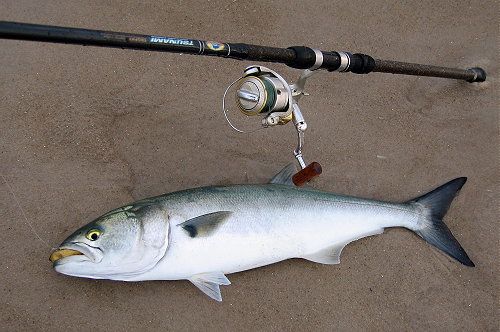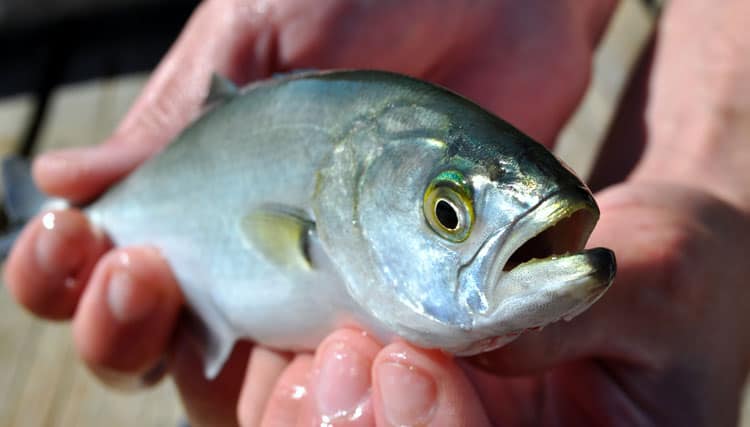It looks like a smaller version of a Bluefish and fights like just like the Slammer that fishermen love with an unquenchable hunger and a nasty reputation but, Is a Snapper Blue a Baby Bluefish?
Snapper Bluefish are baby Bluefish that leave off-shore waters to come inland into shallows Bays, Inlets & Lagoons to feed in Spring & Summer until the Winter when they return to join adult Bluefish to migrate south along the coast towards Florida.
Every year tiny Snapper Blues that are offspring of the Atlantic Bluefish, make their way from Florida to Main with the fighting ability that puts bigger predatory fish to shame.
Is a Snapper Blue a Baby Bluefish
If you are a fisherman from New Jersey then you know a Bluefish is. Blues are popular and run in early Spring and late Fall. Head Boat trips with your buddies are memorable experiences. Some people admire the taste of Blue and some don’t.
I love them on the grill and the secret is to clean them properly like most other gamey-tasting fish. Still, the Bluefish is more popular because of his fighting ability. Bluefish is a migratory, oceanic species found throughout the world in most temperate, coastal regions, except the eastern Pacific.
Bluefish migrate seasonally, moving north in spring and summer as water temperatures rise and moving south in autumn and winter to waters in the South Atlantic Bight. During the summer, concentrations of bluefish are found in waters from Maine to Cape Hatteras, North Carolina.
In winter they tend to be found offshore between Cape Hatteras and Florida. Bluefish are fast growers and opportunistic predators, feeding voraciously on almost any prey they can capture. Bluefish live up to 12 years and may exceed lengths of 39″ and weighs 31 pounds. Bluefish reach sexual maturity at age two and spawn offshore from Massachusetts through Florida.
They can run from around 10 pounds to more than 30 pounds, especially in late October in New Jersey when they are making their return trip down the coast.
Blues are badass and can deliver a fight that can break your pole or reel getting it on board. Once you get it on board taking it off the hook is another lesson in careful patience otherwise you could get some stitches out of the ordeal. If you have never been Bluefish fishing I would highly recommend it.
Bluefish
Snapper Bluefish is the miniature version of the adult Atlantic Bluefish young and small but don’t fool yourself cause these guys are just as ferocious. They have the same kind of fight and bad attitude that make Bluefish the king of nasty on the east coast.
Besides the same features, as their big brothers and sisters have, they share the same type of never-ending appetite that makes them dangerous to anything smaller than they are. Including themselves.
Baby Bluefish or Snappers will come into the Bays, Lagoons, and salt creeks and stay inshore in Spring and Summer to feed, then move offshore in the winter to join the adult Blues for migration along the East Coast down to Florida. Big Blues and Smaller Blues don’t mix no matter the family ties.
The smallest of the young Bluefish are very much like the uncles and aunts in the way they fight and hunt. They look the same with the protruding lower jaw. They have smaller teeth but are just as sharp. The base of the pectoral fin usually has a black blotch. There are two dorsal fins, with the front dorsal being spinier.
You can find Snapper Blues in 4 or 5 feet of water and far inland chasing bait fish. They will chase schools of bait fish and scare them right out of the water banging them left and right from the back of the school. It’s a sight to see.

Snapper Blues (5-10 inches long) in late August in NJ, have a lot in common with the slammers Adult Bluefish found on the eastern shore can be 30 pounds and 40 inches long.
They have the same protruding jaw where the lower jaw comes farther out over the front of the top of his mouth.
This is lined with rows of razor-sharp teeth. They move into the Bay areas to feed and to stay away from their own folks who would have them on the menu.
They attach and feed like schools of bigger Blues in what’s called a “Feeding Frenzy” I’ve seen Bluefish hit beer cans or anything shiny. They are scary fish when they hunt and Snapper Blues are similar in every way.
How To Catch Snapper Blues

I spent hours at the end of my bulkhead waiting for schools of Baitfish to come down the lagoon towards me. Schools of baitfish thousands in a group moving up and down the lagoons.
Sometimes looking like I could walk across the water on them they were so thick that they were called a “Boil”. Following the baitfish from behind was the Snapper Bluefish
They also travel in large schools and feed on schools of baitfish or anything that may get in their way.
They are cannibalistic; all members of a given school are about the same size spawning occurs offshore in spring and summer. There is a reason the smaller 8-inch Snappers are all hanging together leaving the Big Blues behind. Big Blues aren’t particular about what they eat. The little smaller baby Blues would make a nice snack.
Baby Blue Fish
There are plenty of different species of baitfish in the Bay areas. There are Spots, Peanut Bunker, and Mummichogs or Silversides and Spearing. Little Egg Harbor and the Bay area is a breeding grounds for baitfish and bugs. It’s really hard to sit out at night fishing from your dock or bulkhead, in fact, it’s almost impossible. So fish here during the day with any kind of breeze and it will make it tolerable.
Light tackle is all you need 4-6 lb. test and freshwater rod. A favorite rig and bait is a long-shank hook on topwater with a bopper called a Snapper Blue rig with the favorite dinner of Snapper called Spearing which is a native baitfish here in Jersey.
The live bait doesn’t sit very long one is cast towards the back of the school of baitfish where the Snapper hangs out and hunts from the parameter of the school. Keep your line moving a little bit or the trash fish like minnows will strip your hook. Every 5-10 seconds jerk it and that should scare them away.
Long Shank Snapper Hooks are used with frozen Spearing and a Bobber or Popper which are natural baitfish. You can also use a variety of lures as Snapper Blues like their Daddy are quite aggressive and will chase shiny objects.
If you use live bait keep the Spearing frozen it is easier to handle and get it on your hook. What’s left can be frozen again and used the next day. Spearing can be really smelly if you let them unfreeze, so keep the Spearing iced and frozen.
Snapper Fishing
To Bait Your Hook:
- Run the long shank hook through the mouth of the Spearing
- Out his gill
- Down the length of the body then attach him to the hard area just above the tail.

Baitfish like other fish run with tide normally high tide. I fish from my Bulkhead or Dock a few hours before and a few hours after high tide.
Right above the tail on a Spearing is a hard bony part of the fish’s body. Adjust the Popper to the depth of where you want to fish. Normally this is enough weight on your line to cast with some distance.
You can add a split shot or two but you don’t have to cast out very far. Spearing emits a smell and oil that will lure the Bluefish to you. Bring the Popper up 12 to 24 inches. Let the line drift near the school of baitfish.
Bang!
Fishing that plastic bobber or popper sounds like someone threw it down on the concrete and cracked it in half. No doubt a Snapper took the bait. I found that the long shank live bait rig with spearing work the best and you will find an endless supply of Snapper Blues to fill up your cooler.
If you want your kids or grandkids to experience fun fishing and catching, these guys will hit all day.
A dozen or so will be good and make a nice lunch for your family. Late August down the bay fishing for blue fish snappers can be very hot, so make sure you keep plenty of ice on hand and keep the Snappers iced right away, or they will dry up fast from the sun and ruin them.
In New Jersey, There is no closed Season for Snapper Blue, and a normal Harvest Limit is around 15 per person unless otherwise specified by the State. Listen for reports on snapper fishing from Connecticut to Long Island through Jersey and Delaware where snappers are active.
These young-of-the-year small blues are an active fun group of fish to catch. Tasty bluefish snappers caught fresh are good on the grill fun catching with bobbers on the surface makes for fun on the water.
Can You Eat Snapper Blues
Heck Yes, smaller Bluefish is considered the best-tasting Bluefish, especially under 6 or 7 pounds the flesh is very clean. Snapper Blues are even better. Baby snapper bluefish, small as two inches in length, is a great eating fish and not as greasy or gamey tasting as the bigger Bluefish.
Adult blues are an acquired taste and can be oily. Baby snapper bluefish taste much better. The fishing gear is strange looking, especially the bait hooks. Snapper fishing is popular in North Jersey and Long Island in saltwater fishing.
I take the head off and gut them, descale them if you’re leaving the skin on by using your filet knife and holding the fish by the tail to scrape against the grain. Throw them right on the grill. Throw the heads into your crab traps and tie them off your dock. You can have a fish and crab dinner at the end of the day.
If they are big enough you can filet them like you would any small fish. Then flour, salt & pepper, and pan-fry or grill. Don’t forget if you catch these little guys you will most likely catch dozens at a time. There’ll be plenty of fish to go around.
- Take a sharp knife and make a cut below the gills
- Run your knife along the backbone toward the tail
- Cut away the rib cage piece
- remove any bones left over
- rinse the filet
They have a clean fresh tasting meat that is white and has a great texture. They have none of the bloody meat or problems that can happen with big Bluefish that need to be bled out right away. Is a snapper blue a baby bluefish yes, just a better-tasting fish. Active in Spring and early Fall in North Jersey and on the Island in New York along with fluke, the action is good for local and out-of-state anglers.
JimGalloway Author/Editor

